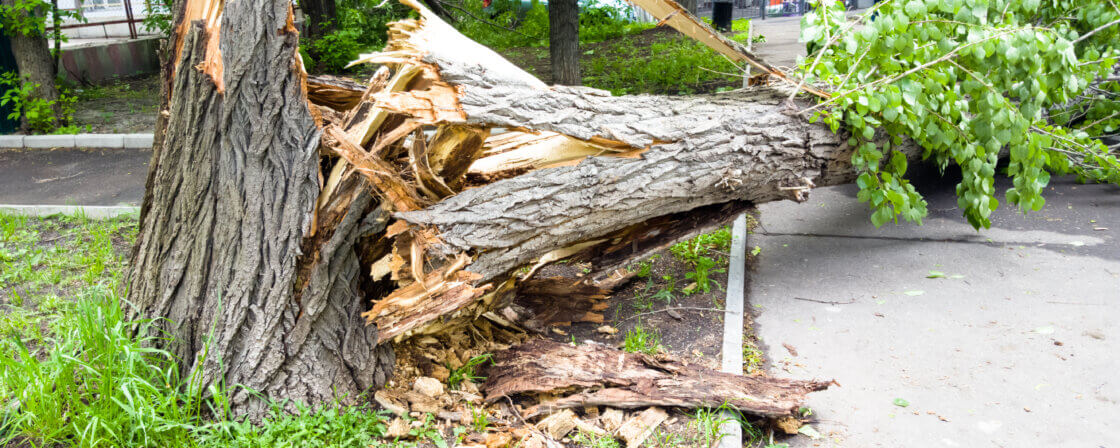Who is liable for tree fall damage
Tree falls are not an uncommon occurrence, especially in high winds or storms. However, the consequences can be severe, ranging from a totaled car to damage to a roof or fence. The key question is who is responsible for the damage and whether you are entitled to compensation. The Civil Code establishes the so-called general duty of prevention, i.e. the duty of everyone to act in such a way as to avoid damage to health, property or nature. If someone breaches this duty and subsequently causes damage, they are liable for compensation.
If a tree falls from a private person’s land (for example, your neighbour), the landowner is liable if they have neglected their duty to keep the tree in a safe condition. This can include situations where the tree was obviously diseased, leaning or rotten and the owner knew or should have known about it. Liability is therefore based on the principle of negligence, not on the ownership itself. The owner is not automatically guilty, it must be shown that he knew of the risk or had the opportunity to have the tree treated or felled.
The situation is different if the tree has fallen from a public place, for example a park or the roadside. In this case, the municipality, the county or the road manager may be liable. The municipality is obliged to take proper care of public green spaces, especially if there was a clear danger – for example, if there were known arborist warnings or if the tree was not maintained for a long time. Again, however, if the damage was caused by an extraordinary event such as a windstorm or hurricane, there may be a ‘force majeure’ and liability does not apply.
In practice, it is often the boundary between normal weather risk and force majeure that is addressed. If a tree fell in normal winds and was in poor condition, it is likely that a court will find the owner liable and you will be entitled to compensation. Conversely, if it was an extreme weather event, liability is extinguished.
Are you solving a similar problem?
Don't they want to reimburse you?
We have extensive experience with cases where clients have had a tree fall on their house or car, as well as cases where they have been flooded by a neighbour. We can help you assess who is responsible for the damage, draft a claim, negotiate with the insurance company and pursue a claim through the courts.
More information
- When you order, you know what you will get and how much it will cost.
- We handle everything online or in person at one of our 6 offices.
- We handle 8 out of 10 requests within 2 working days.
- We have specialists for every field of law.
How to proceed after a tree fall
To successfully claim compensation after a tree fall, it is essential to act quickly and consistently. First and foremost, you need to document the situation. Take detailed photographs of the damaged items, the tree itself, and the area around the fall site. If the fire department or police intervened, ask them to make an official report to serve as evidence. It is also advisable to record testimony from people who were present at the scene – neighbours, passers-by or emergency workers.
Then find out who the tree belonged to. If it is on a property boundary, it may be necessary to check ownership with the Land Registry. Once you are sure of the owner, contact them in writing to claim compensation for the damage. In the notice, describe the incident, attach photo documentation and provide an estimate or invoice for the repair. The more accurate and clearer the documentation you provide, the better your chances of a quick settlement.
If the owner of the tree denies liability, it is advisable to contact an attorney to help you evaluate the evidentiary situation and prepare a pre-suit demand letter if necessary. If no agreement is reached, an action for damages can be brought under the Civil Code. However, you must prove liability – that the tree was in poor condition and that the damage could have been foreseen.
Insurance and compensation after a tree fall
In many cases, insurance can make the road to compensation quicker. If a tree has damaged your car, the situation can be handled through collision insurance. The insurance company will reimburse you for the damage and possibly recover it from the at-fault party afterwards. Home or property insurance works in a similar way, covering damage caused by external influences.
Liability insurance also plays an important role. If the insured owner’s tree is the cause of the damage, their insurance company will reimburse the victim for the cost of repairing or replacing the damaged item. In such a case, the situation is usually resolved out of court and more quickly than if the parties are arguing over fault.
It is important for the victim to report the damage to the insurance company as soon as possible. As a rule, insurance companies require complete documentation – photographs, a description of the incident, reports, an estimate of the damage, and possibly an expert’s report. If the incident was due to a windstorm, it is a good idea to keep a record of the weather alerts as well. Timely reporting and accurate documentation often determine whether the damage will be recognized as an insurance claim.
Tip for article
Tip: You come home and step on wet carpet. You look up and freeze in horror at the absolutely soaked ceiling. Learn what to do to get what you’re entitled to if your home or property floods.
Compensation for damages in case of flooding
Next to tree falls, one of the most common cases of damage in households is flooding of the apartment. Water can cause extensive damage not only to walls and floors, but also to electronics and furniture. The basic rule of thumb is: whoever caused the damage pays for it. Under the Civil Code, anyone who breaches a legal obligation and causes harm to another is liable.
If your neighbour floods your home, he is liable – unless it can be proved that the damage was caused without his fault, for example because of a fault beyond his control. This is typically a burst washing machine hose, a forgotten bath or a faulty appliance connection. If the water leaked from the common parts of the house, for example from a broken riser pipe, the unit owners’ association (HOA) or housing association is liable for the damage.
It is also important to be systematic here. The damage must be documented immediately – ideally in photographs and video. We also recommend that you invite a witness to confirm the extent of the damage and the origin of the water. Then contact the guilty party, write a demand letter and document everything you need. If you have home insurance or liability insurance, you can report the damage to the insurance company. In some cases, there will be a claim on your insurance, which the insurance company will then claim against the neighbour.
Proper communication and timely resolution greatly reduce the risk of protracted disputes. When a neighbor denies liability or the insurance company denies coverage, you should not give up but seek legal help. An attorney can evaluate the situation, help with evidence and draft a pre-suit demand letter so that your claim is enforceable.
How to make a proper claim for compensation
Whether it’s a tree fall or a flooded home, the actual process of claiming compensation is similar. The basics are a written notice describing when and how the damage occurred, what items were damaged and how much you estimate the damage to be. The notice must be accompanied by photographs, receipts, repair invoices or an expert’s report. It is important to be factual, accurate and to support each claim with evidence. We will be happy to help you with drafting.
If the at-fault party doesn’t respond or denies the claim, that’s where a potential lawsuit comes in. The statute of limitations is three years from the time you became aware of the damage and the responsible party, but no later than ten years after the damage occurred. It is therefore not worth waiting. Court proceedings can drag on, but with good evidence and legal help, it is possible to succeed even in cases where the at-fault party initially denies liability.
Tip for article
Tip: Make your dream come true and build a house with a beautiful view of the countryside. But after a few years, something grows on the neighbouring property and you can only look into the windows of your new neighbours. Learn how to defend yourself when your neighbour builds a fence that is too high.
When to contact a lawyer
You should contact a lawyer whenever the at-fault party denies liability, the insurance company has refused to pay, or the damages are extensive and difficult to prove. A lawyer can help you draft a proper claim, assess the liability of the parties and quantify the damages. If necessary, he or she will represent you in negotiations with the insurance company or in court.
Summary
If a tree fall or flooding in your home causes damage, the key is to find out who is liable and how to properly pursue your claim as soon as possible. In the case of a tree fall, liability is governed by the Civil Code and arises where the tree owner has neglected their duty to maintain the tree in a safe condition – for example, by failing to address obvious rot, leaning or damage. A municipality may also be liable if the tree was in a public space and the municipality neglected to maintain the green space. However, if the tree fell as a result of an extraordinary event, such as a severe windstorm, there may be force majeure and there is no claim for damages after the tree fell. In the case of flooding of a dwelling, the person who caused the damage is liable – most often a neighbour if the water leaked from their flat. If it was a burst riser or other common facility in the building, the unit owners’ association or cooperative is liable. Again, the damage must be documented immediately, quantified and claimed in writing. Homeowner’s or liability insurance can also help cover flooding damage, which often covers unintentional damage.
Frequently Asked Questions
Who is responsible for a tree falling from municipal property?
Municipality if it has neglected to take care of the greenery. If it was a natural disaster, liability ceases.
Am I entitled to compensation if a tree falls in the wind?
Yes, if the owner of the tree knew about its poor condition and did not act.
Who pays for flood damage from a burst pipe?
As far as the common parts of the house are concerned, the HOA or cooperative is responsible. If it was the pipes in the apartment, the owner of the apartment.
How long do I have to file a claim?
Three years from the time you became aware of the damage and the culprit.




